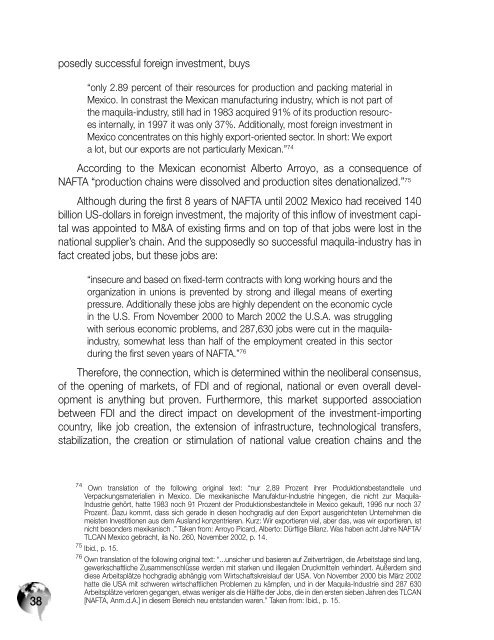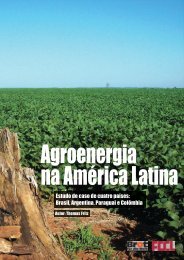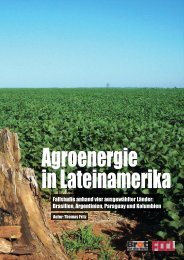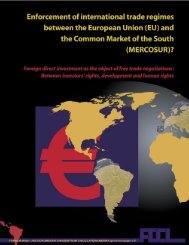Download - FDCL
Download - FDCL
Download - FDCL
You also want an ePaper? Increase the reach of your titles
YUMPU automatically turns print PDFs into web optimized ePapers that Google loves.
38<br />
posedly successful foreign investment, buys<br />
“only 2.89 percent of their resources for production and packing material in<br />
Mexico. In constrast the Mexican manufacturing industry, which is not part of<br />
the maquila-industry, still had in 1983 acquired 91% of its production resources<br />
internally, in 1997 it was only 37%. Additionally, most foreign investment in<br />
Mexico concentrates on this highly export-oriented sector. In short: We export<br />
a lot, but our exports are not particularly Mexican.” 74<br />
According to the Mexican economist Alberto Arroyo, as a consequence of<br />
NAFTA “production chains were dissolved and production sites denationalized.” 75<br />
Although during the first 8 years of NAFTA until 2002 Mexico had received 140<br />
billion US-dollars in foreign investment, the majority of this inflow of investment capital<br />
was appointed to M&A of existing firms and on top of that jobs were lost in the<br />
national supplier’s chain. And the supposedly so successful maquila-industry has in<br />
fact created jobs, but these jobs are:<br />
“insecure and based on fixed-term contracts with long working hours and the<br />
organization in unions is prevented by strong and illegal means of exerting<br />
pressure. Additionally these jobs are highly dependent on the economic cycle<br />
in the U.S. From November 2000 to March 2002 the U.S.A. was struggling<br />
with serious economic problems, and 287,630 jobs were cut in the maquilaindustry,<br />
somewhat less than half of the employment created in this sector<br />
during the first seven years of NAFTA.” 76<br />
Therefore, the connection, which is determined within the neoliberal consensus,<br />
of the opening of markets, of FDI and of regional, national or even overall development<br />
is anything but proven. Furthermore, this market supported association<br />
between FDI and the direct impact on development of the investment-importing<br />
country, like job creation, the extension of infrastructure, technological transfers,<br />
stabilization, the creation or stimulation of national value creation chains and the<br />
74 Own translation of the following original text: “nur 2,89 Prozent ihrer Produktionsbestandteile und<br />
Verpackungsmaterialien in Mexico. Die mexikanische Manufaktur-Industrie hingegen, die nicht zur Maquila-<br />
Industrie gehört, hatte 1983 noch 91 Prozent der Produktionsbestandteile in Mexico gekauft, 1996 nur noch 37<br />
Prozent. Dazu kommt, dass sich gerade in diesen hochgradig auf den Export ausgerichteten Unternehmen die<br />
meisten Investitionen aus dem Ausland konzentrieren. Kurz: Wir exportieren viel, aber das, was wir exportieren, ist<br />
nicht besonders mexikanisch .” Taken from: Arroyo Picard, Alberto: Dürftige Bilanz. Was haben acht Jahre NAFTA/<br />
TLCAN Mexico gebracht, ila No. 260, November 2002, p. 14.<br />
75 Ibid., p. 15.<br />
76 Own translation of the following original text: “...unsicher und basieren auf Zeitverträgen, die Arbeitstage sind lang,<br />
gewerkschaftliche Zusammenschlüsse werden mit starken und illegalen Druckmitteln verhindert. Außerdem sind<br />
diese Arbeitsplätze hochgradig abhängig vom Wirtschaftskreislauf der USA. Von November 2000 bis März 2002<br />
hatte die USA mit schweren wirtschaftlichen Problemen zu kämpfen, und in der Maquila-Industrie sind 287 630<br />
Arbeitsplätze verloren gegangen, etwas weniger als die Hälfte der Jobs, die in den ersten sieben Jahren des TLCAN<br />
[NAFTA, Anm.d.A.] in diesem Bereich neu entstanden waren.” Taken from: Ibid., p. 15.









